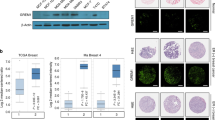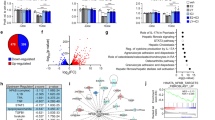Abstract
Transcription factor RUNX3 is inactivated in a number of malignancies, including breast cancer, and is suggested to function as a tumor suppressor. How RUNX3 functions as a tumor suppressor in breast cancer remains undefined. Here, we show that about 20% of female Runx3+/− mice spontaneously developed ductal carcinoma at an average age of 14.5 months. Additionally, RUNX3 inhibits the estrogen-dependent proliferation and transformation potential of ERα-positive MCF-7 breast cancer cells in liquid culture and in soft agar and suppresses the tumorigenicity of MCF-7 cells in severe combined immunodeficiency mice. Furthermore, RUNX3 inhibits ERα-dependent transactivation by reducing the stability of ERα. Consistent with its ability to regulate the levels of ERα, expression of RUNX3 inversely correlates with the expression of ERα in breast cancer cell lines, human breast cancer tissues and Runx3+/− mouse mammary tumors. By destabilizing ERα, RUNX3 acts as a novel tumor suppressor in breast cancer.
This is a preview of subscription content, access via your institution
Access options
Subscribe to this journal
Receive 50 print issues and online access
$259.00 per year
only $5.18 per issue
Buy this article
- Purchase on Springer Link
- Instant access to full article PDF
Prices may be subject to local taxes which are calculated during checkout




Similar content being viewed by others
References
Anderson E . (2002). The role of oestrogen and progesterone receptors in human mammary development and tumorigenesis. Breast Cancer Res 4: 197–201.
Cheskis BJ, Greger JG, Nagpal S, Freedman LP . (2007). Signaling by estrogens. J Cell Physiol 213: 610–617.
Chi XZ, Yang JO, Lee KY, Ito K, Sakakura C, Li QL et al. (2005). RUNX3 suppresses gastric epithelial cell growth by inducing p21(WAF1/Cip1) expression in cooperation with transforming growth factor {beta}-activated SMAD. Mol Cell Biol 25: 8097–8107.
Duong V, Boulle N, Daujat S, Chauvet J, Bonnet S, Neel H et al. (2007). Differential regulation of estrogen receptor alpha turnover and transactivation by Mdm2 and stress-inducing agents. Cancer Res 67: 5513–5521.
Ekena K, Weis KE, Katzenellenbogen JA, Katzenellenbogen BS . (1996). Identification of amino acids in the hormone binding domain of the human estrogen receptor important in estrogen binding. J Biol Chem 271: 20053–20059.
Fan M, Nakshatri H, Nephew KP . (2004). Inhibiting proteasomal proteolysis sustains estrogen receptor-alpha activation. Mol Endocrinol 18: 2603–2615.
Frech MS, Halama ED, Tilli MT, Singh B, Gunther EJ, Chodosh LA et al. (2005). Deregulated estrogen receptor alpha expression in mammary epithelial cells of transgenic mice results in the development of ductal carcinoma in situ. Cancer Res 65: 681–685.
Ito K, Inoue KI, Bae SC, Ito Y . (2009). Runx3 expression in gastrointestinal tract epithelium: resolving the controversy. Oncogene 28: 1379–1384.
Ito K, Lim AC, Salto-Tellez M, Motoda L, Osato M, Chuang LS et al. (2008). RUNX3 attenuates beta-catenin/T cell factors in intestinal tumorigenesis. Cancer Cell 14: 226–237.
Ito Y . (2004). Oncogenic potential of the RUNX gene family: ‘overview’. Oncogene 23: 4198–4208.
Jerry DJ, Dunphy KA, Hagen MJ . (2010). Estrogens, regulation of p53 and breast cancer risk: a balancing act. Cell Mol Life Sci 67: 1017–1023.
Jiang Y, Tong D, Lou G, Zhang Y, Geng J . (2008). Expression of RUNX3 gene, methylation status and clinicopathological significance in breast cancer and breast cancer cell lines. Pathobiology 75: 244–251.
Katzenellenbogen BS, Katzenellenbogen JA . (2000). Estrogen receptor transcription and transactivation: estrogen receptor alpha and estrogen receptor beta: regulation by selective estrogen receptor modulators and importance in breast cancer. Breast Cancer Res 2: 335–344.
Khan SA, Rogers MA, Obando JA, Tamsen A . (1994). Estrogen receptor expression of benign breast epithelium and its association with breast cancer. Cancer Res 54: 993–997.
LaMarca HL, Rosen JM . (2007). Estrogen regulation of mammary gland development and breast cancer: amphiregulin takes center stage. Breast Cancer Res 9: 304–306.
Lau QC, Raja E, Salto-Tellez M, Liu Q, Ito K, Inoue M et al. (2006). RUNX3 is frequently inactivated by dual mechanisms of protein mislocalization and promoter hypermethylation in breast cancer. Cancer Res 66: 6512–6520.
Lonard DM, Nawaz Z, Smith CL, O'Malley BW . (2000). The 26S proteasome is required for estrogen receptor-alpha and coactivator turnover and for efficient estrogen receptor-alpha transactivation. Mol Cell 5: 939–948.
Nawaz Z, Lonard DM, Dennis AP, Smith CL, O'Malley BW . (1999). Proteasome-dependent degradation of the human estrogen receptor. Proc Natl Acad Sci U S A 96: 1858–1862.
Reid G, Hubner MR, Metivier R, Brand H, Denger S, Manu D et al. (2003). Cyclic, proteasome-mediated turnover of unliganded and liganded ERalpha on responsive promoters is an integral feature of estrogen signaling. Mol Cell 11: 695–707.
Sakuma A, Fukamachi H, Ito K, Ito Y, Takeuchi S, Takahashi S . (2008). Loss of Runx3 affects ovulation and estrogen-induced endometrial cell proliferation in female mice. Mol Reprod Dev 75: 1653–1661.
Shoker BS, Jarvis C, Clarke RB, Anderson E, Munro C, Davies MP et al. (2000). Abnormal regulation of the oestrogen receptor in benign breast lesions. J Clin Pathol 53: 778–783.
Subramaniam MM, Chan JY, Soong R, Ito K, Ito Y, Yeoh KG et al. (2009a). RUNX3 inactivation by frequent promoter hypermethylation and protein mislocalization constitute an early event in breast cancer progression. Breast Cancer Res Treat 113: 113–121.
Subramaniam MM, Chan JY, Yeoh KG, Quek T, Ito K, Salto-Tellez M . (2009b). Molecular pathology of RUNX3 in human carcinogenesis. Biochim Biophys Acta 1796: 315–331.
Tateishi Y, Kawabe Y, Chiba T, Murata S, Ichikawa K, Murayama A et al. (2004). Ligand-dependent switching of ubiquitin-proteasome pathways for estrogen receptor. EMBO J 23: 4813–4823.
Yamamura Y, Lee WL, Inoue K, Ida H, Ito Y . (2006). RUNX3 cooperates with FoxO3a to induce apoptosis in gastric cancer cells. J Biol Chem 281: 5267–5276.
Yan P, Fu J, Qu Z, Li S, Tanaka T, Grusby MJ et al. (2009). PDLIM2 suppresses human T-cell leukemia virus type I Tax-mediated tumorigenesis by targeting Tax into the nuclear matrix for proteasomal degradation. Blood 113: 4370–4380.
Yano T, Ito K, Fukamachi H, Chi XZ, Wee HJ, Inoue K et al. (2006). The RUNX3 tumor suppressor upregulates Bim in gastric epithelial cells undergoing transforming growth factor beta-induced apoptosis. Mol Cell Biol 26: 4474–4488.
Zhang DH, Salto-Tellez M, Chiu LL, Shen L, Koay ES . (2003). Tissue microarray study for classification of breast tumors. Life Sci 73: 3189–3199.
Acknowledgements
We thank W Xu for reagents; W Xu, A Nardulli and members in the Chen lab for discussion. This work is supported in part by fund provided by UIUC (to LFC) and NIH grants DK-085158 (to LFC), CA116616 (to GTX) and DK-071909 (to DS). YHT is an A*STAR-Illinois Partnership fellow.
Author information
Authors and Affiliations
Corresponding authors
Ethics declarations
Competing interests
The authors declare no conflict of interest.
Additional information
Supplementary Information accompanies the paper on the Oncogene website
Supplementary information
Rights and permissions
About this article
Cite this article
Huang, B., Qu, Z., Ong, C. et al. RUNX3 acts as a tumor suppressor in breast cancer by targeting estrogen receptor α. Oncogene 31, 527–534 (2012). https://doi.org/10.1038/onc.2011.252
Received:
Revised:
Accepted:
Published:
Issue Date:
DOI: https://doi.org/10.1038/onc.2011.252
Keywords
This article is cited by
-
RUNX3 inactivates oncogenic MYC through disruption of MYC/MAX complex and subsequent recruitment of GSK3β-FBXW7 cascade
Communications Biology (2023)
-
Chromatin accessibility landscape and active transcription factors in primary human invasive lobular and ductal breast carcinomas
Breast Cancer Research (2022)
-
Prolyl isomerase Pin1: a promoter of cancer and a target for therapy
Cell Death & Disease (2018)
-
Shugan Liangxue Decoction (舒肝凉血方) Down-Regulates Estrogen Receptor α Expression in Breast Cancer Cells
Chinese Journal of Integrative Medicine (2018)
-
EZH2 promotes cell proliferation by regulating the expression of RUNX3 in laryngeal carcinoma
Molecular and Cellular Biochemistry (2018)



